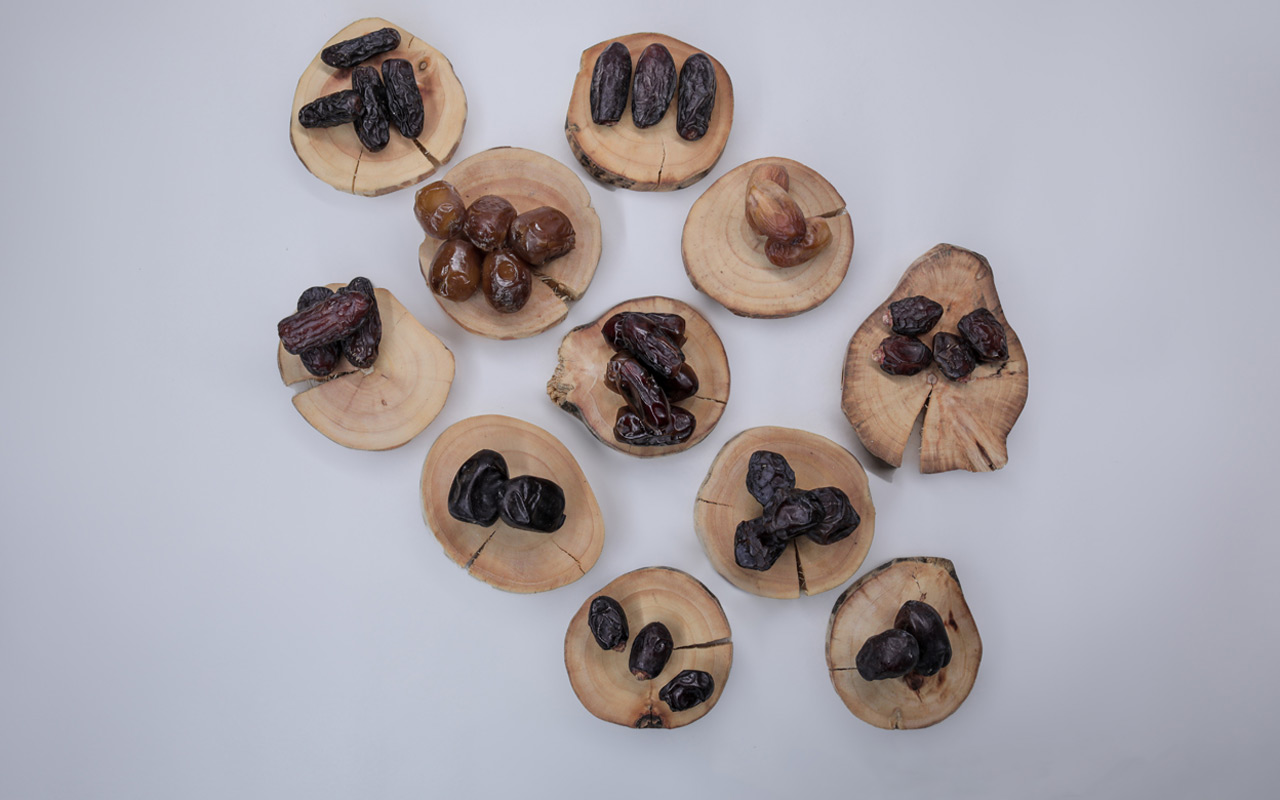Dates are as old as the history of human. Dates have been fundamental food in the Middle East countries for thousands of years and it is called as "a tree of life". It is believed to have originated throughout the Middle East and the Persian Gulf and it was cultivated in ancient Mesopotamia to prehistoric Egypt, possibly as early as 6,000 BC.
It is interesting to know that for growing the palm, a special climate is necessary as local people say: "the date palm requires its feet in the water and its head in the fire of the sky".
Dates are normally lowest in moisture, grown in the dry desert. While most fruits range from 75 to 95 percent moisture, fresh whole dates are less than 30 percent moisture which makes them Nature’s only naturally dried fruit. About 400 varieties of dates are cultivated in Iran but only few of them are commercially important. Iran shares 20 percent of the world date production and is the largest date producer in the world.
Iran produce approximately 250,000 tons of dried date, 600,000 tons of semi-dried and about 250,000 tons of fresh date in some provinces including Kerman, Bushehr, Khuzestan and Hormozgan. The most delicious kinds of dates are produced in Iran. Here are some of the best and well-known types of Iranian date like Mazafati, Piarom, Sayer, Zahedi, Kabkab, Rotab, Rabbi, Kalooteh and Shahani.
Types of Iranian Dates
We supply different kinds of dates:
- Mazafati Dates
- Piarom Date
- Pitted Sayer Dates
- Unpitted Sayer Dates
- Rabbi Dates
- Kabkab Dates
- Zahedi Dates
- Medjool Dates
- Kaloute Dates
Different kinds of Iranian dates separately:
Mazafati Dates
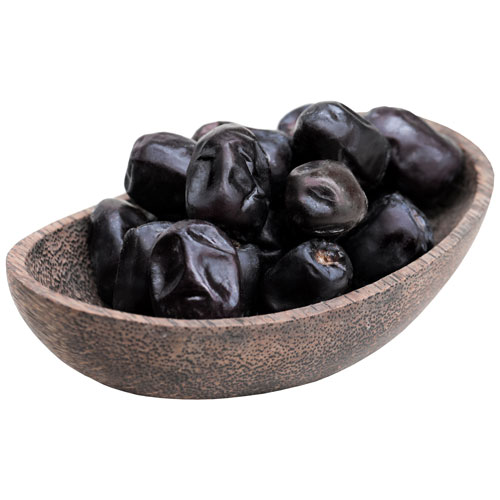 Mazafati is the most popular variety in Iran and known as the pearl of Persia. It’s soft with rich flavor and dark brown in color. Around 120,000 tons of this date is harvested annually. It comes in three types: fresh, semi dry and dry. The product is packed in high quality and modern boxes and in bulk 200, 400 and 600 g cartons.
Mazafati is the most popular variety in Iran and known as the pearl of Persia. It’s soft with rich flavor and dark brown in color. Around 120,000 tons of this date is harvested annually. It comes in three types: fresh, semi dry and dry. The product is packed in high quality and modern boxes and in bulk 200, 400 and 600 g cartons.
Mazafati date appointed date Bam is one of the most famous and different kinds of Iranian date fruit which is usually used as Rutab or Rotab (fresh). This kind of date because of having high moisture is not used as nuts. The date can be considered as the most delicious kind of date fruits in all over the world.
Its moisture depending on harvest time and planting area is between 15% to 35% and the size of the date is usually between 2.5 - 4.5 cm and it has a very useful flesh on it. Natural soft caramel and chocolate could be a description of the taste of this delicious fruit. Our customers are amazed by the sweet and soft melting of this special date.
The most desirable and delicious kind of Mazafati is grown in southern Iranian city of Bam. The Bam region has around 28000 Hectares of the lands under the harvest of Mazafati date from which 5000 Hectares pertains to young palm trees and 120,000 tons of the date is being harvested annually. Other Iranian cities that have suitable condition for planting are Jiroft and Kahnuj in Kerman province, Saravan and Iranshahr in Sistan and Baluchestan province. The ripe Mazafati has dark purple tends to black color. The date should be kept in refrigerator. Mazafati Date sap is so much. To distinguish the quality of these dates, act as if the amount of juice of the date is higher, the quality of those dates is also higher. High quality kind of Mazafati has a thin and soft texture while the low quality has hard and dry texture. There are no any preservatives or chemical additives.
Mazafati just like other kinds of date fruit is replete with health benefits. The date is loaded with needed daily energy and is rich in vitamin B, iron and phosphorous and has a high amount of potassium and vitamin A. Moreover, Mazafati is replete with fiber which is beneficial for those who are suffered from constipation and excess acid in the stomach and actually the date is used as laxative food. Low in fat and totally free from cholesterol, Mazafati dates are wonderful energy boosters as they include natural sugars like glucose, sucrose, and fructose and are really appropriate for health-conscious men and women and are good nourishment for the muscle improvement.
Excellent to eat as they are, in addition to adding it to smoothies, for an original sauce for salad or part of the main meal.
Specifications of Mazafati Date:
Moisture: Between 15-30 %
Shelf Life: 16-24 months depending on the moisture content and storage conditions
Shipment: Reefer container.
Description: Sweet and soft with a heavenly taste
Grade: Fresh (Max 50 per/lb.)/ Semi dry (Max 60 per/lb.)/ Dry & wrinkled
Taste: Sweet
Place of Origin: Kerman (Bam), Iran
Color: Dark purple to black
Texture: Soft & Flesh
Harvest: Mid-September
Usage: Most delicious date for direct eating
Storage condition: -4 - 0℃
Packing: 200 g/400 g/600 g boxes
Piarom Dates
 Piarom dates are known as the most luxurious and expensive variety of Iranian dates that comes from Hormozgan province (Haji Abad area) in the south of Iran. Piarom palms are cultivated mostly in a range of mountains and irrigated basin areas. It should be noted that there are 40 kinds of date in Hormozgan province, which the most cultivated dates in the various areas of the province are Piarom, Mordar Sang, Zard, Allmehtari and etc. Cirueie, Tarom, Tazraj, and Daragah are the villages in the Hajiabad city where the date is cultivated. Hajiabad city is the only area which cultivates Piarom Date. The date is grown organically and there is no chemical in the harvest process.
Piarom dates are known as the most luxurious and expensive variety of Iranian dates that comes from Hormozgan province (Haji Abad area) in the south of Iran. Piarom palms are cultivated mostly in a range of mountains and irrigated basin areas. It should be noted that there are 40 kinds of date in Hormozgan province, which the most cultivated dates in the various areas of the province are Piarom, Mordar Sang, Zard, Allmehtari and etc. Cirueie, Tarom, Tazraj, and Daragah are the villages in the Hajiabad city where the date is cultivated. Hajiabad city is the only area which cultivates Piarom Date. The date is grown organically and there is no chemical in the harvest process.
It is meaty and Semi-Dry with 15% moisture. Growers usually harvest Piarom at the beginning of autumn in October and it takes until the end of November. The color of this unique date is dark brown. Piarom date has thin skin and because of its low sugar, it is acceptable for diabetic people. In international markets, Piarom date is known as Chocolate Date because of unique taste and shape. High quality and good customer satisfaction of Piarom date have made them very special and it attracts most of the prominent international markets. We grade Piarom date into two grades according to size: Jumbo & Standard.
Nutrition and Health Benefits of Piarom
Piarom Date is replete with protein and other mineral substances and has high-quality nutritious value. It has fiber that is very beneficial for the digestive system. Piarom is also a rich source of potassium that is so necessary for preventing high blood pressure and strengthens the nerves. Moreover, the date has a high amount of magnesium that is effective for muscles.
Preparation and Serving Method
Piarom is eaten as it is or may be seeded and stuffed, or chopped and used in a great variety of ways: on cereal, in puddings, bread, cakes, cookies, ice cream or candy bars. The pitting may be done in factories either by crushing and sieving the fruits or, with more sophistication, by piercing the seed out, leaving the fruit whole. The calyxes may be mechanically removed also. The surplus date is made into cubes, paste, spread, powder (date sugar), jam, jelly, juice, syrup, vinegar or alcohol.
Specifications of Piarom Date:
Growing Region: Hormozgan Province (Haji Abad)
Type: Semi-Dry, moisture around 14-16%
Color: Black and Dark Brown in Color
Texture: Soft & Pliable
Harvest Time: in October
Storage Life: 12 Months / in cool and dry place (0 - 4℃)
Usage: Used pitted or unpitted for direct consumption and/or pitted for stuffed dates with kernels
Available Grades: Jumbo (Max 120 pcs/kg) & Standard (Max 140 pcs/kg)
Standard Packaging: 500 g/ 1 kg / 5 kg cartons
Shipment: 20 Foot FCL Container /17 MT
40 Foot FCL Container/28 MT
Sayer Dates
 Sayer or Esta’maran is the most abundant date species which accounts for 65% of Iranian dates. Around 40% of Iranian dates for export is Sayer and it is one of the most important export figures. The shape is slightly elongated, oval and typically dark brown colored and its cross section is yellow. An average weight of fruit is 8.5 grams and kernel weight are 0.9 grams. Sayer Date is the principal kind of date fruit in Khuzestan province (70-80% of palms in Khuzestan province are Sayer dates). Thanks to its high-quality,
Sayer or Esta’maran is the most abundant date species which accounts for 65% of Iranian dates. Around 40% of Iranian dates for export is Sayer and it is one of the most important export figures. The shape is slightly elongated, oval and typically dark brown colored and its cross section is yellow. An average weight of fruit is 8.5 grams and kernel weight are 0.9 grams. Sayer Date is the principal kind of date fruit in Khuzestan province (70-80% of palms in Khuzestan province are Sayer dates). Thanks to its high-quality,
Sayer is well known in many countries especially Canada, England, Australia and New Zealand.
Sayer is available in three types: pitted, unpitted and chopped. The most important specification of Sayer is being semi-dry (its moisture is around 16%). It is capable of storage for a longer period of time than other kinds of dates. It should be noted that the date in Khuzestan province including Sayer Date is totally organic without pesticides or chemicals.
Sayer has a high amount of nutrients and cellulose, so at the point of sugar and nutrition value it is unique and has great syrup. The best-chopped dates are made from Sayer dates and they can be used in cooking or served with tea and other drinks.
Mostly Sayer Dates are harvested in the middle of September. Dates are packed in the great range of packages by Sargol company and distributed in the market.
Specifications of Sayer Date:
Type: Semi-Dry, moisture around 16%
Color: Uniform light brown to dark brown (Reddish)
Length: 3 – 4 cm
Shelf Life: At room temperature about 2 years under interim fumigation
Harvest Time: Mid-September
Growing Region: Khuzestan province
Usage: Used pitted or unpitted for direct consumption and/or for industrial purposes
Packing: Most common packing is 5 kg carton.
Shipment: dry container
Kaloute Dates
Kali Dates, also known as Kaloute Dates and Kaloute Dates are one other type of fresh dates or wet dates in Iran that is same as Bam Mazafati date. Kaloute dates have sweet taste, soft texture, large size, high shelf life (12 – 18 months) & package of retail /bulk and keeping condition at 0 - 5° C temperature. The special features of Kaloute date are low moisture, high fiber and the lower price than Mazafati dates. Kaloute date has a growing market in the most countries such as Tajikistan, Kazakhstan, India, Russia, UAE & Chile.
Sargol Company is the manufacturer and exporter of Kali Dates. Our Kaloute Dates are 100 % Natural, Sweet and tasty. We will perform your orders, and we know that we are judged by our performance, so we strive for your trust.
The Origin of Kaloute Dates
Kali is cultivated in Kerman. It is also well cultivated in most cities of Kerman. Among these cities are Jiroft, Anbarabad, Rudbar, Manoajan, Ghaleh Ganj, River, Faryab and Kahnouj. .It has a world-wide reputation, it is the delicacy of coloute jiroft that delivers the best-selling dates to the market.
Kinds of Kaloute
Kali dates are among the cluster dates. Both dry and wet type are available; hence it is classified as semi-dry dates. It is also possible to refer to the amount of syrup contained in these dates, which is neither much nor low.
These dates can be found in all seasons.
- spring: green Kharg
- Summer: Red and sweet red
- Autumn and winter: brown and pale brown dates
This type of date is well-known for its sweet and tasty flavor, and many fans are eager to use it.
Kaloute Harvesting Time
The date palms are planted in the beam of the moon, followed by the time of pollination in the month. According to climatic and climatic conditions, dates are first grown from southern cities of Kerman in the middle of the month, and by the end of summer (September) it will reach the northern cities of Kerman.
It is important to note that the Kaloute Date should be stored immediately after harvest, in order to prevent its degradation due to having a sap in the palm.
Keeping this type of date requires a very good condition.
For short-term use of this type of date, it can be kept at ambient temperature and this will not be problematic.
But for long-term preservation of this type, it is certainly and absolutely necessary to keep the nicks in a cool place and place.
The use of cooling equipment suitable for transport Kali date, the most important points that should be considered.
The shelf life of Kaloute Jiroft is set to remain healthy when stored at 0 to 5 degrees, from 12 to 18 months.
Usages
These dates are used in different ways. They are served to cook all kinds of pastries and sweets. Also, some colostrum dates are used to produce various types of beverages and alcohol. It can be admitted that the Kaloute Date is also one of the most useful digits of export quotes that are also used on a daily basis as a nutritious and useful food for the general public.
Nutrition and Health Benefits of Kaloute
Kali dates nutritious snack to absorb as much energy for daily activities. The high proportion of these dates is a rich source of minerals and nutrients that provide energy and nutrients to the consumer’s body.
The abundant amount of magnesium in these dates has made the majority of people, especially children, more used to grow and improve the health of the body.
Iron and folic acid in this date is an effective cure for the types of anemia. It is estimated that the amount of trans fatty acids and saturated fats are estimated at 0 g to be a healthy diet for all persons especially obese.
The strengthening of the vision system and eyes is given to Vitamin A in this type of dates.
Specifications of Kaloute Date:
Name: Kaloute- Kaliteh- Kali
Color: Black – Brown
Description: Long, Oval, Soft, Thin, Meaty, Fully-cling to the flesh, 3 – 5 cm
Moisture: 14-17 %
Taste: Sweet with suitable sugar
Shelf Life: At 0 - 5 ° C temperature and cellophane & plastic about 12 - 18 Months.
Quality: Sorted, Cleaned & Semi-waxed (At customer request)
Packaging: 10kg, 5kg Cartons, Small Pack (Under 1kg) and …
Shipment: Dry or reefer container
Place of Origin: Iran
Rabbi Dates
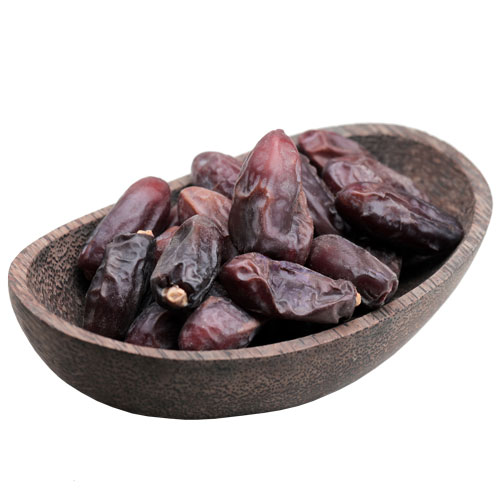 Annually, a wide range of Rabbi dates are cultivated in Iran. In addition to the domestic demand, there is international demand for this Iranian product. Annually, over 20,000 tons of Iranian Rabbi Dates are exported from Iran to various countries. In the international and export markets, the Rabbi date is marketed to palm owners as a semi-dried date fruit which has significant economic benefits.
Annually, a wide range of Rabbi dates are cultivated in Iran. In addition to the domestic demand, there is international demand for this Iranian product. Annually, over 20,000 tons of Iranian Rabbi Dates are exported from Iran to various countries. In the international and export markets, the Rabbi date is marketed to palm owners as a semi-dried date fruit which has significant economic benefits.
For the time being, our Rabbi (Rabbee) dates are exported on large scale to many countries including UAE, Russia, Qatar, India, Kazakhstan, Turkey, Armenia and etc.
Rabbi is stretched and has blackish dark purple and shiny color. This type of dates is red before reaching and the best kind of them grow up in the south of Iran.
Nutrition and Health Benefits of Rabbi
Rabbi date is benefit for us because it is rich in nutrients such as vitamins, minerals and etc.
We are mentioned briefly some of the benefits for you in here:
Rabbi Date fruit has the most economic value so known as pure gold in Sistan and Baluchestan province.
The vital substances of this fruit are Lactose and Fructose which are rich source of natural sugar and is not harmful for those who are suffered from high blood sugar.
Iranian Rabbi Date fruit is an appetizer which prevents gastrointestinal cancer, improves gastrointestinal function, and helps to relieve nervous tensions and treatments of diseases such as Anemia and high fat level.
The Date fruit due to excessive sugar content which mostly includes simple sugars will cause to weight-gain. Latest provided research has shown Dates due to being classified in fruits group includes all benefits of vegetables and fruits; moreover, its trace amount of fat has resulted to be considered as a low-fat nutritious food!
Blood pressure: The Date fruit also is rich source of potassium that is so necessary for preventing of high blood pressure and strengthens the nerves.
Anemia: Dates have a high mineral content, which is beneficial for many different health conditions, but their impressive levels of iron make them a perfect dietary supplement for people suffering from anemia.
Rabbi Date Uses
Dry or soft dates are eaten out-of-hand, or may be seeded and stuffed, or chopped and used in a great variety of ways: on cereal, in pudding, bread, cakes, cookies, ice cream, or candy bars. The pitting may be done in factories either by crushing and sieving the fruits or, with more sophistication, by piercing the seed out, leaving the fruit whole. The calyces may be mechanically removed also. Surplus dates are made into cubes, paste, spread, powder (date sugar), jam, jelly, juice, syrup, vinegar or alcohol.
Also other products such as palm sugar, chocolate, Fruit Bar, raw material of some soft drinks which comes, in addition to high durability, shipping is easy and requires no refrigeration.
Specifications of Rabbi Date:
Harvest time: First week of September
First ready to loading cargo: 3rd week of September
Taste: Little Sweet
Physical properties:
Color: Dark Brown (Reddish)
Length: 4.5 -5.5 cm
Diagonal: 2 cm
Weight: 9 -11 g
Place of Origin: Sistan and Baluchestan/ Iran
Consumer Items: Consumer Packing, Snack, Medicine.
Importer countries: All over the world specially Europe, Russia, Middle East, Far East.
Packaging: 10kg, 5kg Cartons, Small Pack (Under 1kg) and …
Shipment: By dry container
Shelf Life: 12-18 months
Storage Condition: Room Temperature, Need Fumigation each two months.
Zahedi Dates
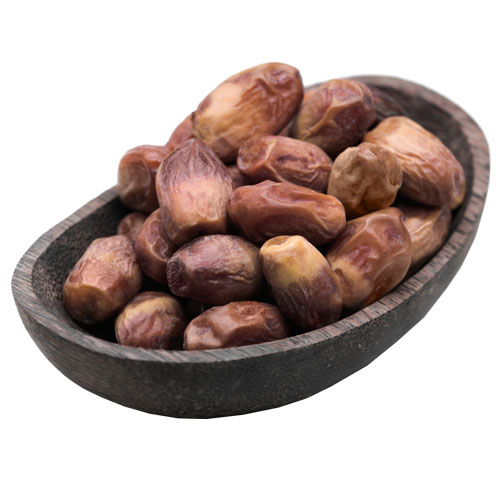 Zahedi Dates is one the dry varieties of the date in most regions of Iran, however, in some regions it is known as a semi-dried date. It is also called as Ghasab in some areas of Iran.
Zahedi Dates is one the dry varieties of the date in most regions of Iran, however, in some regions it is known as a semi-dried date. It is also called as Ghasab in some areas of Iran.
The date is produced in Khuzestan, Fars, Booshehr and Kermanshah provinces, but the main production is in a region called Poshtkooh in Bushehr Province.
There are 4 distinct stages of ripening. In the first stage called Kharak, the skin of Zahedi becomes yellow. At the Rutab stage, dates become light brown and at the final stage, called Tamr dates turn into reddish brown to light yellow.
The date is oval-shaped which is narrower at the end. It can easily be stored all year long. Due to its high sugar content, it can be used for vinegar and alcohol production. Kharak ripens in late August but the harvest season is early-mid September. Zahedi is among the dry dates which ripens late and is subject to premature drops. The main regions for the production of the date are Borazjan, Kazerun, Firoozabad, Bushehr, Jahrom, Lar and Khoramshahr.
Nutrition Fact of Zahedi Date
Zahedi Date due to the natural nutritious substances has high nutritious value. This date is rich of nutrition and contains minerals (potassium, magnesium, protein and etc.).
Vitamins (like vitamin A, vitamin B complex, vitamin C and etc.) and sugars (like fructose and etc.).
100 grams of dried date has about 300 calories and is composed of about 70% carbohydrates, 2.2% protein, and 0.6% fat while fresh dates contain about 160 calories.
Benefits of Zahedi Date
Zahedi Date is Benefit for us because it is rich in nutrients such as vitamins, minerals and etc.
We are mentioned briefly some of the benefits for you in here:
Treatment of diseases: this Date is full of energy and replete of essential vitamins and minerals such as vitamin B, vitamin E, Iron, phosphorous, calcium and magnesium that are very effective for treatment of diseases such as Anemia and Indigestion and improve memory and vision ability.
Blood circulation: The Date contains high Folate content which is beneficial and so necessary for blood circulation.
Weight-gain: The Date fruit due to excessive sugar content which mostly includes simple sugars will cause to weight-gain. Latest provided research has shown Dates due to being classified in fruits group includes all benefits of vegetables and fruits; moreover, its trace amount of fat has resulted to be considered as a low-fat nutritious food!
Specifications of Zahedi Date:
Harvest: First week of October
First ready to loading cargo: Mid of October
Taste: Sweet
Physical properties
- Color: Dark Brown (Reddish)
- Length: 3 – 4 cm
- Diagonal: 1.5 – 2 cm
- Weight: 7 – 9 g
- Semi-Dry
Grading
- Grade A
- Grade B
Consumer Items: Snack, Medicine, Dates Paste, Industrial.
Importer countries: All over the world especially East Europe, Russia, North America, Middle East, Far East.
Area under cultivation: South of Iran
Type of packing: 10 kg Cartons, 5 kg Cartons, Small Pack (Under 1 kg).
Shelf Life: 2 years
Storage Condition: Room Temperature, Need Fumigation every two months.
Kabkab Dates
One of plenitude and important dates in south of Iran. This type of dates is bigger than others. They have opal dark red to blackish brown color and very small core. High-grade of Kabkab growing up in south of Iran. Core oval, elongated, gray, skin stack to the fleshy part.
Kabkab Date Nutritional Facts
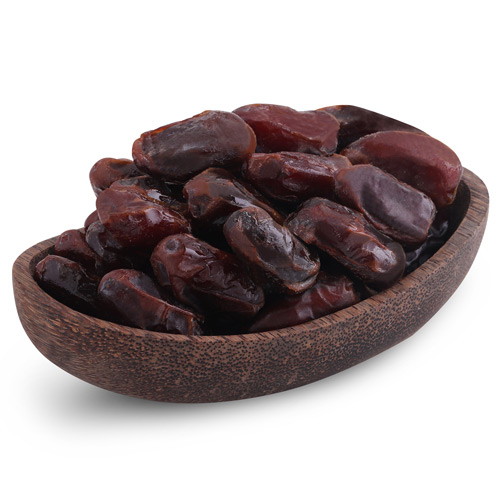 All dates due to their natural nutritious substances have high nutritious value. Kabkab date, Zahedi date, Piarom date, Rabbi date, and bam fresh Mazafati dates are all rich in nutrients and contain minerals (potassium, magnesium, protein, etc.), Vitamins (like vitamin A, vitamin B complex, vitamin C, etc.) and sugars (like fructose, etc.).
All dates due to their natural nutritious substances have high nutritious value. Kabkab date, Zahedi date, Piarom date, Rabbi date, and bam fresh Mazafati dates are all rich in nutrients and contain minerals (potassium, magnesium, protein, etc.), Vitamins (like vitamin A, vitamin B complex, vitamin C, etc.) and sugars (like fructose, etc.).
The date fruit consists of 70 % carbohydrates (mostly sugars), making it one of the most nourishing natural foods available to man. The water content is between 15 to 30% depending on the type and on the maturity stage of the fruit.
In most varieties, the sugar content of a date fruit is almost entirely of the inverted form (namely glucose and fructose), important for people who cannot tolerate sucrose. The invert sugar in dates is immediately absorbed by the human body without being subject to digestion like ordinary sugar. The flesh of dates contains 60 to 65% sugar, about 2.5% fiber, 2% protein and less than 2% fat, minerals, and pectin substances. Date fruits are also a good source of iron, potassium and calcium, with a very low sodium and fat content. In addition, moderate quantities of chlorine, phosphorous, copper, magnesium, silicon and Sulphur are also found in the date fruit.
Its high content of magnesium (±600 mg/1kg of dates) could also be very beneficial.
With only 1 mg of sodium per 100 g, dates are good food for those who are on a low sodium diet. The iron content of 3 mg per 100g is almost a third Recommended Dietary Allowance for an adult male. Note that fiber, even though not a nutrient for humans is of much value in a diet as an aid to digestion and evacuation. There is ample evidence that for most people a diet fairly high in fiber is healthier than one low in fiber.
Furthermore, dates are a good source of vitamins A, B1 (thiamine), B2 (riboflavin), and B7 (nicotinic acid also called niacin). The following contents per kilogram are an average for all date varieties: vitamin A, 484 international units; B1, 0.77 milligram (mg); B2, 0.84 mg; and B7, 18.9 mg.
Specifications of Kabkab Date:
Name: Kabkab Dates
Variety: Wet Dates
Shape: Black-Brown, Long, Oval, Round, Soft, Meaty &Fully-Cling to The Flesh
Taste: Sweet & Delicious
Size: Medium & Large
Moisture: under %18
Quality: Sorted, Cleaned, Washed & Dried
Keeping Condition: No Refrigeration Needed
Shelf Life: 12 - 18 Months
Packaging:
Cartons Packs: Different sizes
Packaging: 10kg, 5kg Cartons, Small Pack (Under 1kg) and … .
Labeling: Available
Place of Origin: Iran
Shipment: Dry Container
Harvesting Time: Mid-September.




